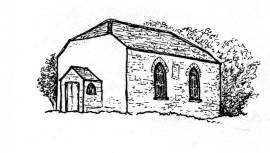| The
Non Conformists Chapels in the Glasbury Area
This article was prepared by M. A. V. Gill in 2005 for the "Glasbury Book" (unpublished), It was first published with annotations in Brycheiniog Vol XVIII 2012 . The excellent artwork is also by the same local author |
NONCONFORMIST CHAPELS AND MEETINGHOUSES In a period when so many Nonconformist chapels throughout Wales are being made redundant and demolished or converted to secular use, no fewer than three in the parish of Glasbury appear in Anthony Jones’ monograph Welsh Chapels (1984), listed as buildings which should be “saved at all costs”: Maesyronen, Capel-y-ffin and Treble Hill, each representative of a different period and style of chapel building. In J.W. Hobbs’ reminiscences, he describes the Chapel Sunday school Anniversaries as great events, when children and adults would give songs and recitations: “One year a grand ‘Dialogue’ was given by the men of the Chapel. It was called ‘Noah’s Ark’ and the part of the patriarch was taken by the white haired old stationmaster, Mr. Jones. There were about a dozen men and boys taking part, but the only two names I remember were a Mr. Holder and the jovial old Precentor, Mr. James Morgan, who added a touch of humour by rushing in, getting stage fright and instead of the grandiloquent speech he should have delivered, looking blankly around and then blurting out, ‘the river has ruz, and I’m feared as most of my ships have been washed away’. I was a sinner who repented and arrived after Noah had entered the Ark (the Chapel vestry), and heard the solemn words from inside ‘Too late, too late, the door is shut, you cannot enter now!’”. PEN-YR-HEOL BAPTIST CHAPEL
Initially a branch of Maesyberllan, in 1819 Pen-yr-heol was recognised as an independent church and a member of the Baptist Association. The religious census taken on 30th March 1851 records that while 173 persons actually attended the evening service on the day of the census, there was space for three hundred. This seems an extravagant estimate, as a gallery does not appear to have been installed until 1860. The gallery was later removed, the original side-wall entrance sealed and a new porch erected at the north end. In the logbooks of Velindre School, head-teachers occasionally noted events at the local chapels that affected pupils’ attendance. On 19th October 1885: “Very poor attendance, many children gone to Penrheol Harvest Thanksgiving”; in the weekly report of 25th July 1904: “Anniversary at Penrhoel – so many scholars have applied for half holiday that this along with another circumstance caused head teacher to omit usual marking of Registers, though we dismissed at usual time. The circumstance alluded to was a terrific thunderstorm with torrents of rain, entirely precluding those at a distance leaving the shelter of their homes”; again on 20th July 1914: “Owing to the boisterous & wet state of the weather, & also to a Tea Party taking place at Penrheol Chapel, only a dozen children present in the afternoon”. The memoir of Mary Kinsey (née Harris) recalls such Anniversary services held every year. As a child in the 1890s she used to recite at both afternoon and evening services on the Sunday; then there was another service on the Monday when tea was prepared for everyone who came. Below Penyrheol Cottage was a pool hewn out of the rock; she and her mother went “one Sunday morning when there were twenty baptised at the Dipping Pool. After the dipping we went to a house where the members had a hot drink and changed into dry clothing”. The last one she remembers was when there was snow on the ground! Source : -- "A Chapter on the Churches and Chapels in the Parish of Glasbury " by M.A.V. Gill
|
 Another
eighteenth century Baptist foundation was that of Pen-yr-heol, situated
at the end of the road in the hills above Velindre. Meetings are
said to have been held first at Island Farm in the parish of Llanigon,
or at Pen-yr-heol Farm, the home of John Thomas (minister of Maesyberllan).
With an increasing congregation, it was decided to build a chapel.
Land was acquired by a title deed dated 14th November 1783, and
the building with its hipped roof and pointed round-headed windows
was completed the following year.An inscribed tablet on the side
wall above the original entrance records the chapel’s endowment:
‘The Memoir of / TWO HUNDRED AND / FORTY POUNDS of The / Pious
Donation of / Thomas Williams / of the Island, GENT / in the Parish
of / Llanigon and County / of Brecon to and / for the Use and Benifit
/ of this Pen-y-heol / Church for Ever’; the date is no longer
legible, but apparently once read: “Ibi., Sept. ye 1st. 1788”
(less than a week before the donor’s death).
Another
eighteenth century Baptist foundation was that of Pen-yr-heol, situated
at the end of the road in the hills above Velindre. Meetings are
said to have been held first at Island Farm in the parish of Llanigon,
or at Pen-yr-heol Farm, the home of John Thomas (minister of Maesyberllan).
With an increasing congregation, it was decided to build a chapel.
Land was acquired by a title deed dated 14th November 1783, and
the building with its hipped roof and pointed round-headed windows
was completed the following year.An inscribed tablet on the side
wall above the original entrance records the chapel’s endowment:
‘The Memoir of / TWO HUNDRED AND / FORTY POUNDS of The / Pious
Donation of / Thomas Williams / of the Island, GENT / in the Parish
of / Llanigon and County / of Brecon to and / for the Use and Benifit
/ of this Pen-y-heol / Church for Ever’; the date is no longer
legible, but apparently once read: “Ibi., Sept. ye 1st. 1788”
(less than a week before the donor’s death).